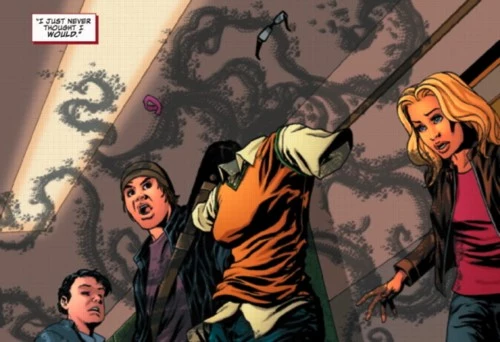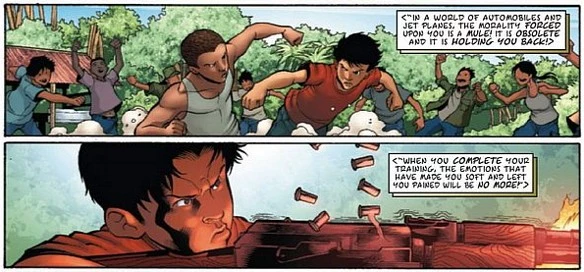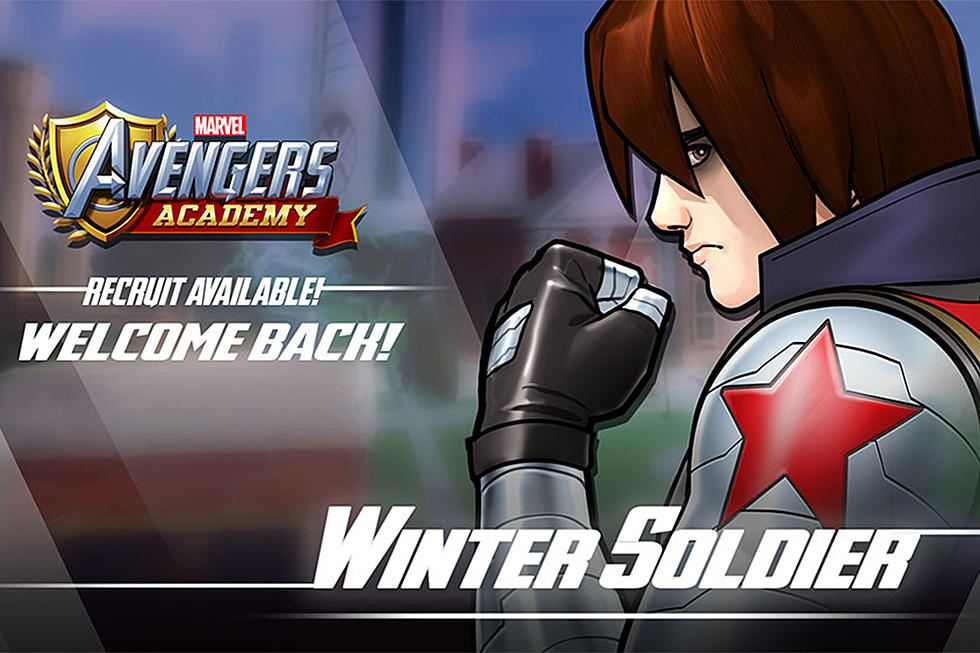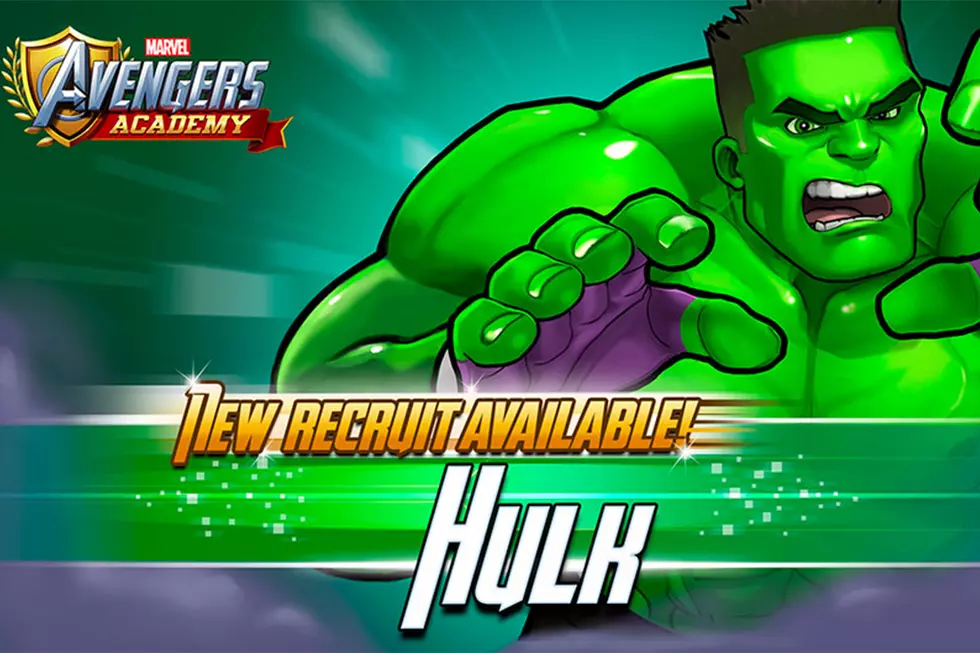![Worried About the Kids: Avengers Academy #1 / Young Allies #1 [Review]](http://townsquare.media/site/622/files/2010/06/academyallies1.jpg?w=980&q=75)
Worried About the Kids: Avengers Academy #1 / Young Allies #1 [Review]
WORRIED ABOUT THE KIDS - Avengers Academy 1 / Young Allies 1

The fate of young superheroes is a peculiar one. In the real world young men and women are taught the skills they will need to run the world by an older generation, with the knowledge that some day these youths will take up the positions of leadership and responsibility abandoned by their elders as they age, move on and eventually pass away.
In the world of superhero comics, though, the oldest generation of heroes tend to be the most popular, so much so that their continued existence is guaranteed, and their future of maintaining a hold on the same responsibilities assured as long as their publishers stay in business. The younger heroes, on the other hand, don't have the benefit of a life expectancy that stretches out long past an infinite horizon. Because the established older generation of heroes is never going to permanently disappear from their roles, the next generation of heroes becomes in a group of young, energetic go-getters with nothing to really do, and so they become expendable. And when someone needs to turn up dead to have an emotional impact, the unfortunate victim tends to be pulled from their ranks.
So with that in mind, be careful about forming any strong connections to any of the characters from Marvel's two latest youth team books, "Avengers Academy" and "Young Allies." Because if history is any indication at least one of these eleven youngsters is due for a tragic, meaningful death sure to upset a newly gained cult following at some point in the next few years.Between those two the situation looks more dangerous for the "Avengers Academy" group. Written by Christos Gage with art by Mike McKone, "Avengers Academy" follows six young heroes, each of whom were experimented upon and tortured by Norman Osborne's regime in order to develop their superpowers. Now under the tutelage of a team of instructors led by Hank Pym and including Speedball, Tigra, Justice and Quicksilver, each member of the group is attempting to overcome their troubled pasts and live up to the potential they've been told they have.
Except that, in an excellent twist by Gage, they're actually being kept around so that their instructors can monitor them and make certain they don't develop into the supervillains everyone else is secretly afraid they'll become. It sets up excellent tension for the future of the book, considering how troubled some of the young team are. There's Finesse, a gymnast assassin who may be a sociopath with a superiority complex. There's Hazmat, who has to wear a protective suit to prevent every around her from dying, and is not pleased about this. And there's Striker, who shoots electricity from his hands and needs to be the center of attention all the time.

The actual center of attention for this issue, though, is Maddy Berry, a.k.a. Veil. Her body can transform into a gaseous cloud, but unfortunately for Maddy this means she's slowly coming apart molecule by molecule, and she is dying. Maddy's an interesting focal point character because Gage does a great job of making her believable as someone who wants to do good but could easily tip onto the side of evil in the wrong circumstances. And when the teachers responsible for keeping her off the wrong path include individuals with such stellar decision making track records.
There's Hank "you always and repeatedly hurt the ones you love" Pym, there's Speedball, who only recently ended the phase of his life where he felt it necessary to where a costume with spikes on the inside in order to stop feeling so bad, and Quicksilver, whose powers of super speed have seemingly enabled him to switch rapidly between good guy and bad guy. The presence of such questionable role models only serves to up the sense of dramatic tension and fear of impending disaster.
Meanwhile in another #1 one issue about a teen team, the "Young Allies" have it a little more together, in that only one of them had harrowing experiments performed on them by a corrupt military regime. Written by Sean McKeever with art by David Baldeon, the series follows the adventures of five young heroes all based in New York. There's Rikki Barnes, the female Bucky of another world trying to find her place in the traditional Marvel Universe, and Arana, the superhero who is emphatically not Spider-Girl and who's struggling to be a hero without powers, both fresh from the pages of their recent back-up series. Joining them are Firestar, who recently survived cancer only to contract a debilitating case of graduate school enrollment, Gravity, whose uniform logo sadly does not include an apple striking Isaac Newton on the head, and Toro, who despite being the aforementioned ex-child soldier seems like a pretty nice guy for someone with horns and hooves.

Interestingly in "Young Allies" #1 it's not the heroes who're stuck in the shadow of older generations. It's actually the villains, the self-titled Bastards of Evil, a group of children of supervillains out to make a name for themselves. They're presented as almost the capes and tights version of a group of children carrying out a school shooting, in that their primary motivation is to do as much damage as possible and be remembered by a world they feel unjustly ignored them. The worst case of the bunch is Warhead, the son of the Radioactive Man, who takes fairly extreme measures at the end of the issue.
Honestly, while the rest of the book was fine but not amazing, the ending had me scratching my head and wrinkling my brow in slightly confused disapproval. As the Bastards of Evil appear in New York and the Young Allies form up for the first time to stop them, Gravity and Warhead's battle carries them into the construction area at the former site of the World Trade Center. At which point Warhead decides it would be "iconic" and "memorable" if he were to blow himself up and re-explode Ground Zero. Which he does, leading to a splash page of a green mushroom cloud going up over the site.
Now, I'm not necessarily someone to immediately condemn a creator for touching on such a sensitive subject. But what bothers me about McKeever's choice here is that it comes off as an afterthought. By having his bad guys blow up the site of the towers, again, McKeever is attempting to show that these are definitely not good people and they would stoop to just about anything in order to show off how evil and strong they are. Yet the coincidental way in which it all happens out of nowhere in the last three pages of the book doesn't properly acknowledge the significance of what's happening.
If somehow the Bastards had specifically planned to attack Ground Zero in order to show off how mustache-twistingly evil they were, it would have been cheesy or maybe even a bit disrespectful, but it would have been a clear statement by McKeever on how bad his bad guys are supposed to be. But he way the issue was constructed, Warhead could have ended the fight by choosing to explode anywhere, and the twist that it's the World Trade Center site merely feels like a tacky late addition made to strike a raw nerve, leaving an unpleasant aftertaste in an otherwise acceptable issue.
More From ComicsAlliance



![Why Hasn’t There Been An ‘Avengers Academy’ Comic Adaptation Yet? [Kids’ Comics]](http://townsquare.media/site/622/files/2016/08/AAFeatured2.jpg?w=980&q=75)


![David Nakayama Discusses Creating Marvel Avengers Academy’s Fun and Colorful World [Exclusive]](http://townsquare.media/site/622/files/2016/05/avengers-acad-lead.jpg?w=980&q=75)
![‘Secret Avengers’ By Remender & Hardman and ‘Avengers Academy’ Meet Runaways [NYCC 2011]](http://townsquare.media/site/622/files/2011/10/untitled-2-1318701876.jpg?w=980&q=75)
![Marvel’s Next Big Thing: Murder at ‘Avengers Academy’ [Comic-Con]](http://townsquare.media/site/622/files/2011/07/avengersacademy21main.jpg?w=980&q=75)
